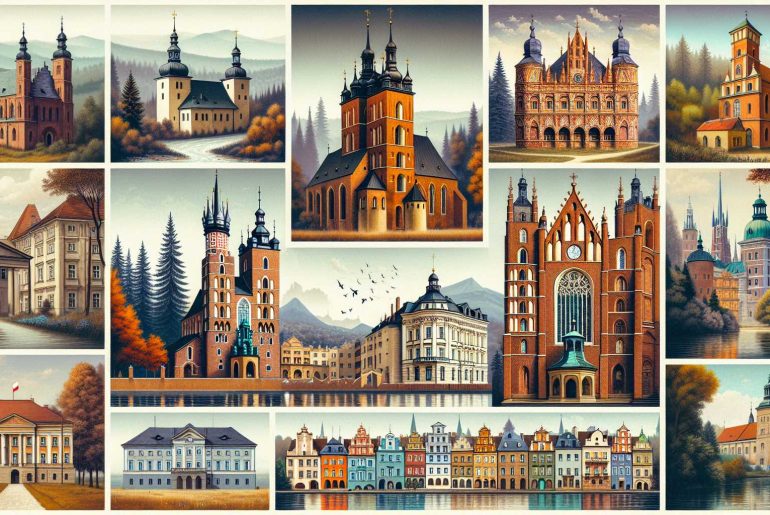
Poland’s architecture tells a story, showing us the country’s history through its buildings. You can see everything from Medieval Gothic buildings with their tall spires to the smooth, elegant lines of Neoclassical designs.
During the Renaissance, Poland embraced classic ideas and merged them with local styles. Then came the Baroque era, famous for its detailed and fancy decorations. Moving forward, Modernist architecture added a new twist, combining old traditions with new ideas.
This mix of styles in Poland’s buildings isn’t just about looks; it tells us about the country’s past and the different influences that shaped it. Understanding these architectural styles helps us appreciate the richness and variety of Poland’s culture and history. So, let’s talk about it like we’re exploring Poland’s city streets together, discovering the stories behind each building.
Medieval Gothic Marvels
In Poland, the Middle Ages were a time of great architectural achievement, especially with Gothic buildings. These structures were not just for show. They had practical uses as places for people to gather, worship, and even defend themselves. More than that, they were a source of pride for the communities that built them. Polish Gothic architecture took inspiration from Western Europe but added its own twist. This included unique features like pointed arches, ribbed vaults, and flying buttresses.
The skill level of the builders and craftsmen during this period was remarkable. They paid attention to every detail, creating buildings that were as beautiful as they were functional. For example, the St. Mary’s Basilica in Krakow is an iconic Gothic structure in Poland. Its intricate altarpiece and stunning stained glass windows showcase the craftsmanship of the time.
These medieval buildings tell us a lot about the people who lived in Poland during the Middle Ages. They reveal a society that valued creativity, community, and resilience. Today, these Gothic marvels are not just historical landmarks. They continue to inspire and attract visitors from around the world, reminding us of Poland’s rich cultural heritage.
Renaissance Rebirth
Between the late 15th and early 17th century, Poland witnessed a significant shift in architectural styles, thanks to the Renaissance period. This time was all about embracing new ideas while moving away from the Gothic style, which was known for its height and intricate designs. Instead, Polish Renaissance architecture looked to the ancient Romans and Greeks for inspiration, focusing on harmony, proportion, and balance.
One of the coolest things about Renaissance architecture in Poland was how it mixed Western European styles with local traditions. This blend brought to life features like the ‘Polish attic’, which are decorative parapets, and arcaded courtyards that added a unique touch to buildings. But it didn’t stop there. Poland was also famous for its wooden construction. During the Renaissance, architects managed to combine these wooden building techniques with the new Renaissance style. This led to the creation of wooden manor houses that were not only beautiful but also showcased the ingenious merger of local carpentry skills with Renaissance ideas about space and design.
These architectural innovations did more than just change the way buildings looked. They played a major role in Poland’s cultural and societal growth during this period. By integrating new styles with traditional methods, Poland set the stage for future architectural developments.
Imagine walking through a Renaissance-era manor in Poland. You’d see the elegance of the Renaissance design with its clear, balanced spaces. Then, you’d notice the wooden details, a nod to Poland’s building traditions, all seamlessly combined. It’s this unique blend that made Polish Renaissance architecture stand out and contribute significantly to the country’s cultural evolution.
Baroque Grandeur
After the Renaissance, Polish architecture entered the Baroque period. This era stood out for its bold and intricate designs, moving away from the simpler styles that came before it. Baroque architecture in Poland is easy to recognize because of its dramatic spaces, detailed decorations, and overall sense of excitement and tension in the designs.
Unlike the Renaissance, which focused on balance and harmony, Baroque buildings are all about making a statement. They often feature elaborate facades and decorations that draw the eye and create a feeling of grandeur.
One of the main goals of Baroque architects was to impress and convey the strength and majesty of the Catholic Church, which was a major supporter of art and architecture at the time. This is evident in many of the churches and cathedrals from this period, which are designed to evoke a sense of wonder and spirituality.
For example, the Church of Saints Peter and Paul in Kraków is a classic piece of Baroque architecture. Its façade is intricately detailed, and inside, the space is designed to make visitors feel both awe and intimacy with the divine. This approach to design has left a lasting impact on Poland, contributing to its rich cultural and aesthetic heritage.
Neoclassical Elegance
In the late 18th century, Polish architecture took a significant turn, moving away from the elaborate and flamboyant designs of the Baroque period. This change wasn’t just about looks; it mirrored deeper intellectual and cultural shifts of the Enlightenment era. The Enlightenment was a time when people started valuing reason and looked back to the ancient Greek and Roman civilizations for inspiration. So, Polish architects began adopting the Neoclassical style, which is all about simplicity, symmetry, and nods to classical antiquity.
This style showed up in the design of grand public buildings, luxurious homes, and city layouts that focused on balanced proportions and minimal decoration. Architects of the time looked up to the ancient works of Vitruvius, the Renaissance genius Palladio, and even modern thinkers like Le Corbusier. They borrowed classic elements like columns, pediments, and friezes to craft buildings that stood for the democratic values and rational thought of their time.
For example, imagine walking through a city where every building has clean lines, grand columns that reach for the sky, and pediments that remind you of ancient temples. This isn’t just about making things look pretty; it’s about making a statement. These buildings were a physical representation of the ideals of democracy, reason, and a return to the wisdom of ancient civilizations.
In adopting the Neoclassical style, Polish architects were doing more than just following a trend. They were making a bold statement about their values and the kind of society they wanted to build. This shift in architectural style speaks volumes about the power of design not just to decorate, but to embody and communicate the most profound ideals of a culture.
Modernist Innovations
As the 20th century dawned in Poland, architects embarked on a journey of modernization, moving away from past styles to embrace the principles of Modernism. This period was a game-changer, driven by the need to solve real-world problems like the demand for more housing and better public spaces. Architects like Helena and Szymon Syrkus, along with Bohdan Lachert, who was a follower of the famous Le Corbusier, were at the forefront of this movement. Their work went beyond just creating buildings that looked good; they focused on how these structures could improve people’s lives.
Modernist architecture in Poland stood out for its clean lines and minimalistic approach. The architects of this era were pioneers in using new materials like steel and reinforced concrete, which not only allowed for more innovative designs but also made buildings safer and more durable. A great example of this is the Warsaw Housing Cooperative projects by the Syrkuses, which combined practical living solutions with aesthetic simplicity, embodying the essence of Modernist architecture.
This era was not just about changing how buildings looked; it was also about rethinking their purpose. Modernist architects in Poland were deeply influenced by the social and political challenges of their time. They saw architecture as a tool to build a better society, where buildings were designed to meet the needs of the community, not just the desires of the wealthy. This vision led to the creation of spaces that were not only functional but also fostered a sense of community among their inhabitants.
Conclusion
Poland’s architecture tells a fascinating story of Europe’s design evolution. From the sturdy Gothic castles of the medieval period to the balanced beauty of Renaissance structures, the decorative flair of Baroque, the clean lines of Neoclassicism, and the practical approach of Modernism, Poland showcases a wide range of styles.
This variety mirrors Poland’s complex history and its active engagement in Europe’s cultural discussions. In simple terms, by looking at Poland’s buildings, you can get a crash course in European architecture and how it has changed over the years.







Comments are closed.